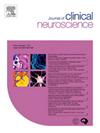FIB-4评分是急性缺血性脑卒中患者接受静脉溶栓治疗的预后因素吗?
IF 1.9
4区 医学
Q3 CLINICAL NEUROLOGY
引用次数: 0
摘要
背景:肝功能障碍被认为是卒中后预后不良的危险因素。FIB-4指数,一种预测肝纤维化的实验室测试,已被证明是有效的。与心脑血管疾病预后不良相关。的目的。本研究旨在探讨FIB-4评分与出血的关系。急性缺血性脑卒中患者接受静脉溶栓治疗(IV tPA)后的转化、死亡率和预后方法对255例急性静脉注射tPA的患者进行记录。对缺血性脑卒中进行回顾性分析。患者分为两组。根据FIB-4评分分为:1组(FIB-4≤2.67)、2组(FIB-4 >;2.67)。人口学数据、入院时NIHSS评分、THRIVE评分、颅内出血率(使用海德堡出血分类、NINDS和ECASS标准进行症状性颅内出血)、卒中病因亚型(使用自动病因分类系统)。分类系统),并记录第3个月mRS评分。结果经logistic回归分析,2组患者年龄较大,第3个月mrs评分较高,3个月内死亡率高于对照组。第一组(p≤0.05)。虽然2组患者颅内出血发生率较高,但差异无统计学意义。结论FIB-4指数可作为急性缺血性脑卒中患者静脉注射tPA后不良预后的有效预测指标。需要大规模的前瞻性研究来证实这种关系,并为临床实践提供有价值的见解。本文章由计算机程序翻译,如有差异,请以英文原文为准。
Is the FIB-4 score a prognostic factor in acute ischemic stroke patients receiving intravenous thrombolytic therapy?
Background
Liver dysfunction is recognized as a risk factor for poor outcome after.
stroke. The FIB-4 index, a laboratory test for predicting liver fibrosis, has been shown to be.
associated with poor prognosis in cardiovascular and cerebrovascular diseases. The aim of.
this study was to explore the relationship between FIB-4 score and hemorrhagic.
transformation, mortality, and prognosis in patients with acute ischemic stroke who received.
intravenous thrombolytic therapy (IV tPA).
Methods
The records of 255 consecutive patients who received IV tPA for acute.
ischemic stroke were retrospectively reviewed. Patients were divided into two groups.
according to their FIB-4 scores: group 1 (FIB-4 ≤ 2.67) and group 2 (FIB-4 > 2.67). The.
demographic data, NIHSS scores at admission, THRIVE scores, intracranial bleeding rates,
(using the Heidelberg Bleeding Classification, NINDS and ECASS criteria for symptomatic.
intracranial hemorrhage), stroke etiology subtypes (using the automated Causative.
Classification System), and mRS scores at the third month were recorded.
Results
On logistic regression analysis, group 2 patients were older, had higher mRS.
scores at the third month and had increased mortality within 3 months when compared with.
group 1 (p ≤ 0.05). Although group 2 patients had a higher rate of intracranial hemorrhage,
the difference was not statistically significant.
Conclusions
The FIB-4 index may serve as a a useful predictor of poor prognosis in patients with acute ischemic stroke who received IV tPA. Large-scale prospective studies are needed to confirm this relationship and provide valuable insights for clinical practice.
求助全文
通过发布文献求助,成功后即可免费获取论文全文。
去求助
来源期刊

Journal of Clinical Neuroscience
医学-临床神经学
CiteScore
4.50
自引率
0.00%
发文量
402
审稿时长
40 days
期刊介绍:
This International journal, Journal of Clinical Neuroscience, publishes articles on clinical neurosurgery and neurology and the related neurosciences such as neuro-pathology, neuro-radiology, neuro-ophthalmology and neuro-physiology.
The journal has a broad International perspective, and emphasises the advances occurring in Asia, the Pacific Rim region, Europe and North America. The Journal acts as a focus for publication of major clinical and laboratory research, as well as publishing solicited manuscripts on specific subjects from experts, case reports and other information of interest to clinicians working in the clinical neurosciences.
 求助内容:
求助内容: 应助结果提醒方式:
应助结果提醒方式:


